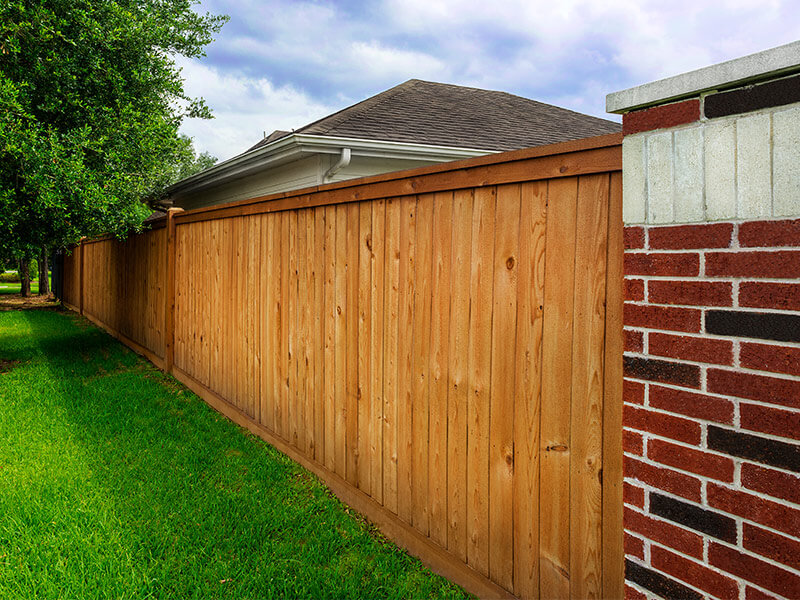Full Fence Replacement – #1 Fence Installers
When we’re faced with a deteriorated or outdated fence, a complete replacement often becomes necessary. We’ll explore the critical aspects of this significant home improvement project, from evaluating your current fence to selecting the ideal materials for your needs. While the process may seem challenging, understanding the key factors involved can make all the difference in achieving a successful outcome. As we embark on this journey, you’ll discover why proper planning and professional guidance are essential for enhancing your property’s aesthetics, security, and value. But before we delve into the details, let’s consider the unexpected advantages that a new fence can bring to your home and lifestyle.

Key Points
- Assess the current fence condition and research local regulations to determine replacement needs.
- Choose appropriate fencing materials based on durability, aesthetics, and cost-effectiveness.
- Consider both initial installation costs and long-term maintenance expenses when budgeting.
- Obtain multiple quotes from professional contractors to ensure competitive pricing and quality workmanship.
- Plan for additional features like gates, post caps, and landscaping that may impact the overall project cost.
Assessing Your Fence Replacement Needs
Before starting on a complete fence replacement project, we’ll need to carefully assess your current fence’s condition and replacement requirements. Our team will examine your existing fence for structural issues, including deteriorating posts, damaged boards, and other issues that may warrant a total overhaul. We’ll evaluate the materials used in your current fence and discuss potential upgrades to more resilient options that align with your preferences and budget. Considering various wood choices such as cedar, redwood, and pine can offer both visual appeal and strength.
Next, we’ll research local ordinances and regulations to make certain our replacement plan meets all requirements. This step is essential for avoiding costly mistakes and potential legal concerns. We’ll then obtain multiple quotes from professional fence installers to compare costs and services. These estimates will include both labor expenses and the cost of quality materials.
As part of our assessment, we’ll factor in additional features you may want, such as gates, ornamental elements, and landscaping considerations. This detailed approach ensures that we address all your fencing needs while maximizing cost-effectiveness and longevity for your new fence.
Choosing the Right Fencing Materials
When starting a full fence replacement, selecting the appropriate fencing materials is vital for guaranteeing longevity, aesthetics, and cost-effectiveness. As property owners, we must consider various factors to determine the best material for our specific needs. Wood fencing offers affordability and versatility, while vinyl provides durability with minimal maintenance. Aluminum fences combine strength with low upkeep requirements, and wrought iron delivers a classic aesthetic for those seeking elegance.
Opting for quality material guarantees peace of mind and longevity, which is essential for long-term satisfaction.
To make an informed decision, we should evaluate the following aspects:
- Initial installation costs vs. long-term repair expenses
- Lifespan of materials (e.g., 15-20 years for wood, 20-30 for vinyl)
- Annual maintenance requirements and associated labor hours
- Environmental impact and recyclability of materials
- Compatibility with local climate and soil conditions
Cost Considerations for Full Replacement
We’ll examine the key cost factors for full fence replacement, beginning with material selection. Opting for quality materials guarantees durability and longevity, which can save money in the long run. Additionally, professional installation can prevent potential issues that might require costly repairs later.
We’ll also consider how additional features, such as gates or specialized finishes, can impact the overall project cost.
Material Selection Impacts Cost
One of the most significant factors influencing the cost of a full fence replacement is the selection of materials. When undertaking this project, we must carefully consider the impact of our material choices on both upfront expenses and long-term maintenance costs.
High-end options like wrought iron or vinyl fencing can substantially increase the overall project budget, while more economical alternatives such as chain link fences or wooden structures can help keep costs down.
As we plan our full fence replacement, let’s examine the following factors related to material selection:
- Initial cost per linear foot
- Lifespan and durability ratings
- Maintenance requirements and associated expenses
- Aesthetic appeal and property value impact
- Local zoning regulations and homeowners’ association guidelines
Labor Expenses Vary Widely
Beyond material selection, labor expenses represent a significant variable in the overall cost of a full fence replacement project. We’ve noticed that homeowners typically invest between $800 and $1200 for labor alone. This wide range is attributed to several factors that impact labor costs.
The extent of replacement and complexity of terrain play vital roles in determining labor expenses. When we come across rough terrain or challenging spots, additional time and materials are often necessary, increasing the overall labor costs for a full fence replacement.
Similarly, higher-quality materials can require extra care and installation time, further influencing labor expenses.
As fellow property owners, we acknowledge the importance of considering these labor charges when budgeting for a full fence replacement. The significant contribution of labor to the total project cost can’t be underestimated.
We recommend thoroughly evaluating your property’s unique characteristics and discussing them with fencing professionals to obtain accurate labor estimates. By taking into account these variables, we can make informed decisions and guarantee our fence replacement projects are carried out efficiently and within budget, aligning with our community’s standards and our individual property needs.
Additional Features Affect Pricing
When considering a complete fence replacement, it’s essential to account for additional features that can greatly impact the overall cost. We must carefully weigh the benefits of incorporating premium materials, customized gates, and advanced security features against their impact on our budget. The inclusion of decorative elements or intricate designs can notably increase the total expenditure for a new fence installation.
As fence industry professionals, we recognize that these enhancements can elevate the aesthetics and functionality of your complete fence replacement. However, it’s crucial to balance desires with financial constraints. Opting for high-quality wood or ornate metalwork may result in a 30-50% increase in material costs.
Similarly, integrating specialized design elements like arched gates or custom paint finishes can add 15-25% to the overall project cost. By carefully considering these factors, we can help you achieve the perfect balance of style, security, and affordability in your new fence installation.
Planning and Permitting Process
We’ll begin our planning process by conducting a thorough zoning regulations assessment, ensuring our fence replacement project adheres to local ordinances and setback requirements.
This assessment involves reviewing municipal codes, property surveys, and any applicable HOA guidelines that may impact our design and installation.
Once we’ve confirmed compliance, we’ll initiate the permit application procedures, which typically include submitting detailed plans, paying associated fees, and scheduling inspections with the local building department.
Zoning Regulations Assessment
Compliance with local zoning regulations forms the foundation of any successful fence replacement project. We must carefully evaluate these regulations before proceeding with our plans. Zoning laws dictate vital aspects of our fence, including height, materials, and placement on our property. By understanding these regulations, we guarantee our project aligns with local standards and avoid potential setbacks.
A thorough zoning evaluation involves:
- Verifying allowable fence heights for front, side, and rear yards
- Confirming approved materials for our neighborhood’s aesthetic standards
- Determining required setbacks from property lines
- Evaluating any restrictions on fence styles or designs
- Identifying permit requirements for our specific project
This evaluation helps us navigate the intricate landscape of local ordinances and streamline our fence replacement process.
We’ll need to obtain necessary permits to demonstrate conformity with zoning regulations. Failure to adhere to these standards can result in costly fines or the need to reconstruct our fence entirely.
Permit Application Procedures
Handling the permit application procedures is a crucial step in our complete fence replacement project. We must first consult local authorities to determine specific permit requirements for our area. These procedures vary by jurisdiction, so it’s crucial we familiarize ourselves with our local regulations.
To initiate the process, we’ll need to gather necessary documentation. This typically includes property surveys, detailed fence specifications, and proposed designs. We should be prepared to submit these along with any required application fees. Some localities may demand more detailed plans, so we must be thorough in our preparation.
Our compliance with local regulations is vital. By understanding and adhering to the permit application procedures, we guarantee a smooth replacement process and avoid potential fines or project delays.
Let’s approach this step methodically, double-checking all requirements and submitting a complete application package.
Hiring Professional Fence Contractors
Many homeowners choose professional fence contractors when embarking on a complete fence replacement project. These fencing contractors bring expertise and quality workmanship to guarantee a successful outcome. When selecting a professional for full fence replacement, we’re investing in their knowledge of material and labor requirements, as well as their ability to efficiently execute the project.
Professional contractors offer several advantages for new fence installation:
- Expertise in proper installation techniques
- Access to specialized tools and equipment
- Knowledge of local building codes and permit requirements
- Ability to handle unexpected challenges during the project
- Guidance on selecting the right materials for durability and aesthetics
By hiring a fencing contractor, we’re not just paying for labor; we’re investing in their experience and industry-specific knowledge. They can advise on best fence height, post spacing, and gate placement to maximize security and functionality. Additionally, professional contractors can efficiently remove the old fence and dispose of materials properly, saving us time and effort.
When we work with experienced professionals, we’re joining a community of homeowners who prioritize quality and longevity in their property improvements.
Let’s ensure our complete fence replacement project is executed with precision and expertise by partnering with skilled contractors.
Maintaining Your New Fence
Every newly installed fence requires diligent maintenance to ensure its longevity and aesthetic appeal. We must implement a thorough maintenance regimen to protect our investment. Regular cleaning and inspections are essential components of this process, as they allow us to identify and address potential issues before they escalate.
To safeguard our wooden fences, we should apply a high-quality sealant or stain. This protective layer shields the wood from UV radiation, moisture penetration, and fungal growth. Additionally, we must be vigilant about trimming nearby vegetation, as overgrowth can cause structural damage to our fencing.
Let’s consider the following maintenance schedule:
| Task | Frequency | Tools | Duration |
| Inspection | Quarterly | Flashlight, notepad | 30 minutes |
| Cleaning | Bi-annually | Pressure washer, detergent | 2-3 hours |
| Sealing/Staining | Annually | Brush, roller, sprayer | 4-6 hours |
| Hardware check | Semi-annually | Screwdriver, wrench | 1 hour |
Frequently Asked Questions
How Much Should I Budget for a New Fence?
We recommend budgeting $5,000 to $15,000 for a standard residential fence installation. However, for custom designs with premium materials, allocate up to $15,000+. Consider factors like linear footage, height, and gate specifications to accurately estimate your project’s cost.
What Is the New Fence Law in Texas?
We’re not aware of a new fence law in Texas. The existing “Fence Law” still applies, requiring property owners to maintain their fences. Co-ownership of boundary fences remains, and written agreements for cost-sharing are essential for neighborly relations.
How Much Does It Cost to Replace a Fence in Houston?
We’re looking at a range of $5,000 to $15,000 for standard residential fence replacement in Houston. Factors like linear footage, material selection, and post-setting depth influence cost. For custom designs, we’re talking $15,000+. Let’s discuss your specific needs!
Who Is Responsible for the Fence Between Houses in Texas?
In Texas, we’re co-responsible for boundary fences on property lines. We share maintenance duties with our neighbors. For fences entirely on our land, we’re solely responsible. Let’s communicate clearly to avoid disputes over fence obligations.
The Takeaway
We’ve explored the critical aspects of full fence replacement, from initial evaluation to long-term upkeep. By following local zoning ordinances, choosing suitable materials like galvanized steel or pressure-treated lumber, and collaborating with certified fence installers, we’ll guarantee a successful project. Remember to consider post-hole depth (usually 24-36 inches), panel height limitations, and gate clearances. Routine checks and treatments, such as using wood preservatives or rust inhibitors, will prolong our fence’s lifespan and preserve its structural integrity.








